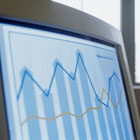The stock market has jumped and the economy shows signs of perking up, but Americans continue to lose jobs. What’s in store for the rest of the year and the year to come?
Most economists and market watchers are optimistic – to a point. But some warn that many of the nearly three million jobs lost over the past three years are gone for good.
The Standard & Poor’s 500 is up about 18% this year, and the Nasdaq Composite nearly 40%. An early September survey by Barron’s found that top Wall Street analysts expected stocks to rise another 5 to 10% by the end of the year.
But on Sept. 5 the Labor Department reported that non-farm payrolls fell by 93,000 in August, while most polls showed a majority of economists had expected an employment increase. Unemployment remained above 6%. It did drop slightly – but only because many discouraged workers had stopped looking for jobs.
“Today’s unemployment was not good,” Wharton finance professor Jeremy Siegel said that afternoon. “But there is a coordinated global rise in the economy. We see Japan and the emerging markets beginning to do much better. Europe is still sluggish, but there are signs it might follow. I think we’re on the verge of a global expansion.”
Wharton finance and economics professor Franklin Allen concedes that most economists and market observers think the recovery is gaining strength, but he worries that “it won’t last.” The Federal Reserve’s low-interest-rate policy has given investors cash, which is flowing into stocks and driving prices up, he said. But he warns that this will stop if mortgage and other interest rates continue their recent rise, and he cautions that high corporate and consumer debt levels – as well as foreign competition in manufacturing – are serious overhanging problems. “The recovery won’t be as strong as people expect,” Allen said.
In recent surveys, economists have generally been upbeat about prospects for the rest of this year and for 2004, with many believing the U.S. gross domestic product is growing at a healthy 3.5 to 5% annual rate this quarter, up from a fairly good pace of 3.1% in the spring. Hiring is often one of the last economic indicators to improve during a recovery.
“We believe real gross domestic product is on track to grow at least 4% this quarter,” Bob Doll, chief investment officer of Merrill Lynch Investment managers, wrote in a Sept. 8 market analysis. “Consumer spending [growth] could easily be higher than 5%, and capital expenditures [by businesses] this quarter will likely grow 10%.”
Liz Ann Sonders, chief investment strategist for Charles Schwab, noted in a Sept. 5 analysis that “while some investors think we are due for a correction, I expect the market to go higher from here to year-end…
“The market is finally reconnecting to the economy, a link that’s typically tight but fell apart during the multiple crises of trust, recession and war. If gross domestic product growth approaches the 5% level, I think the market still has room to move upward.”
Productivity – and Lost Jobs
The Sept. 5 jobs report said manufacturing employment had its 37th straight month of losses. About 2.7 million manufacturing jobs have been lost in that period, or 16% of the manufacturing workforce.
While most categories showed job losses, there was one notable exception: temporary help, where there was a modest increase of 7,000. Together, the data suggests employers have some need for additional workers but are too skittish about the economy to hire full-time employees.
Also, worker productivity grew at a 6.8% annual rate in the second quarter, nearly triple the long-term average. Computerization and other technological improvements allow fewer workers to do more work. “Productivity is stunning, and that’s what’s causing the job decline,” Siegel said.
A recent study by two Federal Reserve economists, Erica Groshen and Simon Potter, found that in recent years layoffs during downturns tend to be permanent, while in the past they were temporary.
Soaring productivity is one reason; another is competition from cheap foreign labor. “I think people are just beginning to talk about China,” Allen said. “I think there’s not enough appreciation of how tough the competition with China is going to be over the next few years.”
The U.S. is pressing China to let its currency float, on the theory the currency would rise, pushing up the cost of Chinese goods in the U.S. and taking some pressure off American manufacturers. But Allen says it’s unlikely China will float anytime soon. If it did, the decision could backfire by causing defaults among China’s many overextended borrowers, he said. An economic crisis in China could ripple around the world, he warned.
Throughout the recession and the slow recovery that has followed, robust consumer spending has shored the economy up. This was possible, in large part, because falling interest rates allowed homeowners to refinance mortgages, freeing up cash for spending.
Business Spending: Up for Down?
But signs of economic recovery and other factors, such as the growing federal budget deficit, are causing mortgages and other interest rates to rise. Mortgage applications have begun to fall.
“I think long rates will continue to go up, and that will have an effect on the housing market,” Allen said. “Once people realize housing prices may not keep rising and may begin falling, they will realize that their debt levels are very high and that they have to cut back.”
If homeowners sell stocks to generate cash, stock prices could fall, he said. And tighter consumer spending could weaken the recovery – or reverse it. Workers who have lost jobs, or worry they will, are likely to trim spending.
The weak point in the economy of the past few years has been business spending. Though interest rates have been low, many businesses have not invested in new facilities because they have continued to sit on the overcapacity built in the ‘90s, when soaring stock prices made it easy to raise money for expansion.
But manufacturers have closed plants, airlines have retired planes, developers have slowed construction of office buildings. As excess capacity melts away, businesses will eventually begin spending to replace old facilities and to expand.
“You’re beginning to see a pickup in business sentiment,” Siegel said. Intel, for example, has recently raised its forecast for chip demand, he noted. “We’re beginning to see some strong optimism” that could lead to increased business spending.
Finance professor Andrew Metrick, who studies the venture capital and private equity markets, says these areas are beginning to perk up. “It’s a bit easier to arrange for financing than it was 12 months ago,” he said. “The IPO market is showing signs of life again.”
Investment in high risk venture capital and private equity markets is more an indication of business sentiment than the availability of money, he noted. If business people are jittery, they won’t spend even if money is cheap and plentiful.
Optimism among business people and investors is also buoyed by the perception that President Bush is likely to be reelected, Siegel said. Markets generally prefer stability to change and tend to prefer conservative economic policies.
Rising confidence could easily be shaken by a major terrorist attack or deepening trouble in Iraq, Siegel added, and rising bond yields could cause investors to shift money from stocks to bonds, undermining stock prices. But the stock market tends to do well in the third year of a presidential term, he noted. The economy and financial markets face fewer problems now than earlier in the year. There is little talk these days, for example, about the threat of deflation.
Also, corporate profits have been rising. It now looks like fiscal 2003 operating earnings for the S&P 500 companies will create a price-to-earnings ratio of about 20, Siegel predicted. “I’ve argued a 20 P/E is okay. Analysts have forecast a 15% to 20% rise in operating earnings next year, which could cause a healthy rise in stocks.
“I think 2004 will be a good year for the stock market.”



